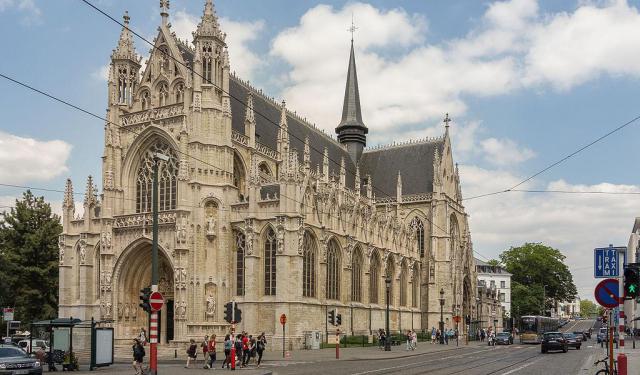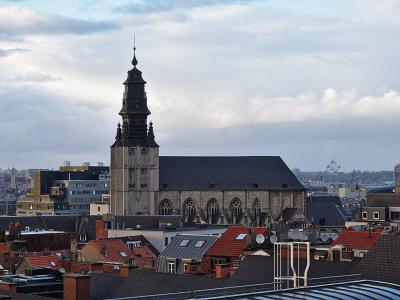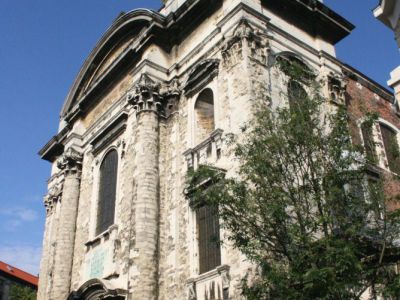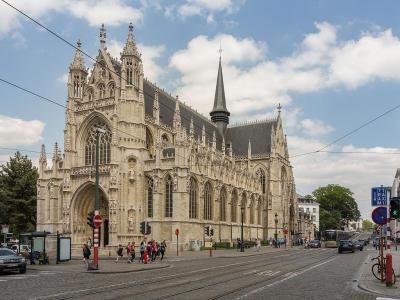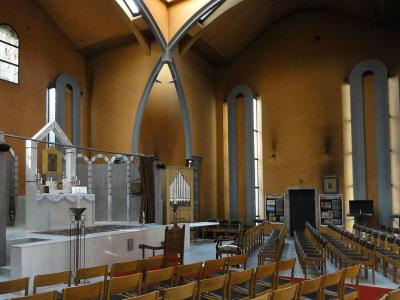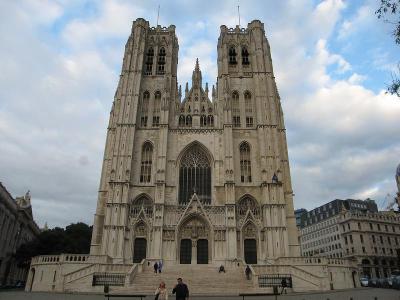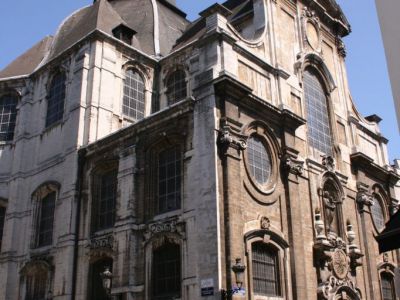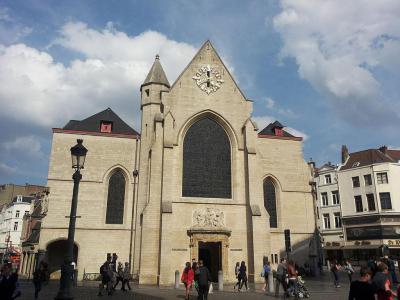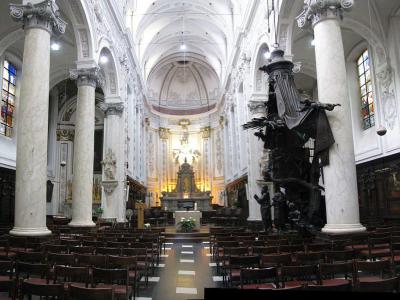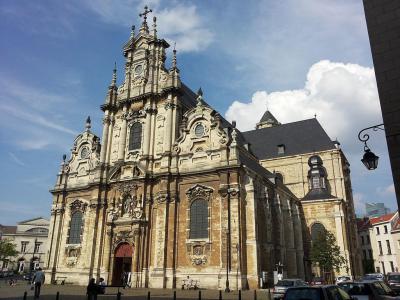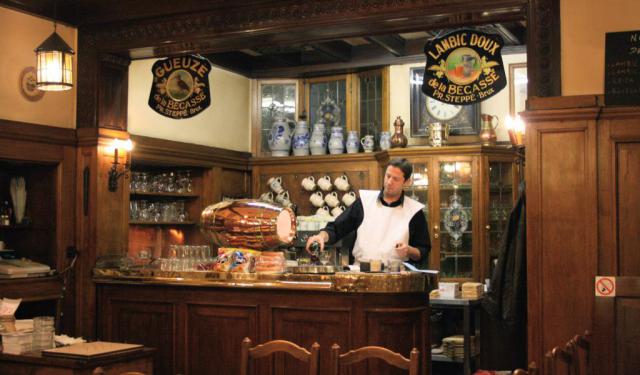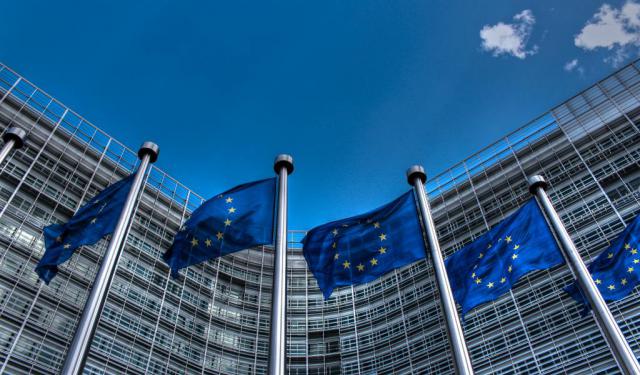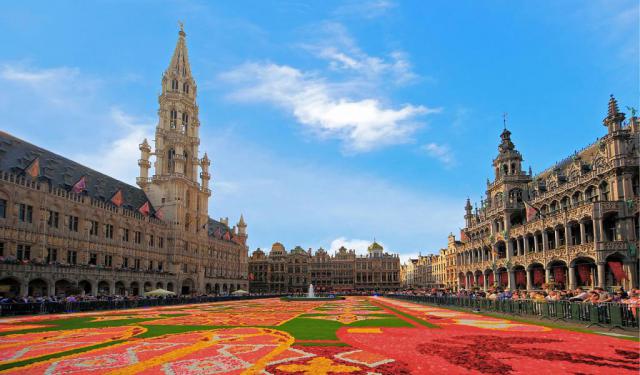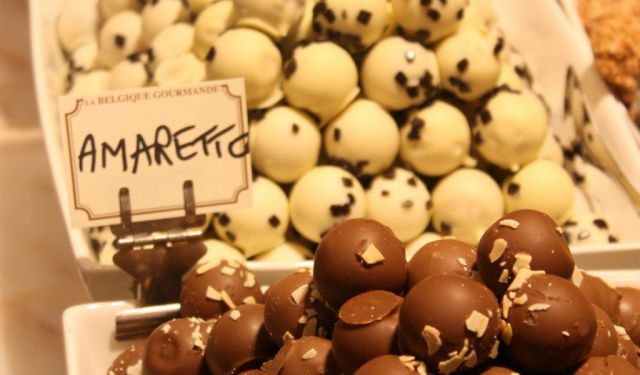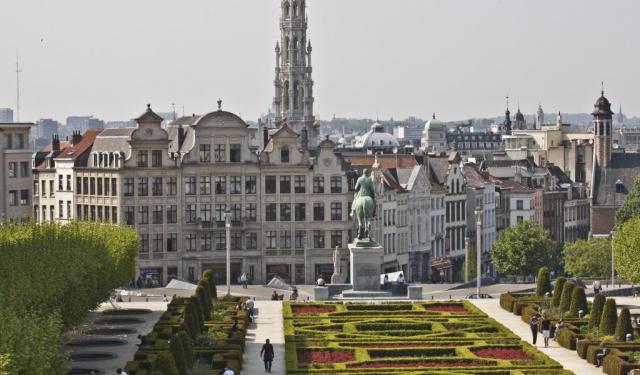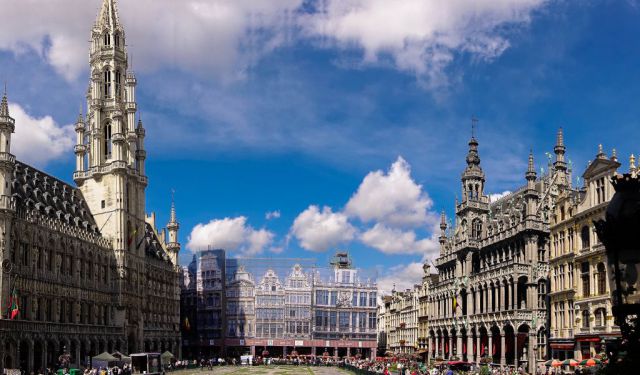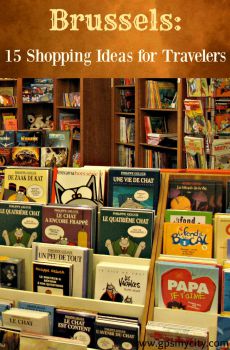Brussels Historical Churches Walking Tour (Self Guided), Brussels
As well as being Belgium’s political and cultural capital, Brussels is the spiritual home of its most significant churches. Historically, the city has been predominantly Roman Catholic, especially since the expulsion of Protestants in the 16th century. The pre-eminent Catholic temple here, located just a couple of minutes from the Grand-Place, is the Brabantine Gothic Cathedral of St. Michael and St. Gudula, which sports a striking twin-towered, white stone facade. Begun in 1215, and 300 years in the making, it remains a prominent feature in the skyline of downtown Brussels.
Another gorgeous church, this time down near the Royal Museums area, the medieval Notre-Dame du Sablon has impressive exteriors with ornate decorations and designs. Inside there are some fascinating things to see, such as the sculptures and the altar, but most of your time will be spent looking at the glorious stained glass windows, reminiscent of the Sainte-Chapelle in Paris. After your visit, feel free to spend some time at the antique stalls and shops in the nearby Place Sablon!
Among other highlights in the area are the Saint Nicolas Church, dating back over 1,000 years, and surrounded by similarly old-looking houses, or the Baroque church of Saint Jean Baptiste – the only building left from the Béguine convent founded on the site in the 13th century, whose facade is considered to be one of the most beautiful in Belgium.
Neglecting such treasures is like leaving Brussels without having waffles, so take our self-guided walking tour to catch a glimpse of some exquisite places of worship.
Another gorgeous church, this time down near the Royal Museums area, the medieval Notre-Dame du Sablon has impressive exteriors with ornate decorations and designs. Inside there are some fascinating things to see, such as the sculptures and the altar, but most of your time will be spent looking at the glorious stained glass windows, reminiscent of the Sainte-Chapelle in Paris. After your visit, feel free to spend some time at the antique stalls and shops in the nearby Place Sablon!
Among other highlights in the area are the Saint Nicolas Church, dating back over 1,000 years, and surrounded by similarly old-looking houses, or the Baroque church of Saint Jean Baptiste – the only building left from the Béguine convent founded on the site in the 13th century, whose facade is considered to be one of the most beautiful in Belgium.
Neglecting such treasures is like leaving Brussels without having waffles, so take our self-guided walking tour to catch a glimpse of some exquisite places of worship.
How it works: Download the app "GPSmyCity: Walks in 1K+ Cities" from Apple App Store or Google Play Store to your mobile phone or tablet. The app turns your mobile device into a personal tour guide and its built-in GPS navigation functions guide you from one tour stop to next. The app works offline, so no data plan is needed when traveling abroad.
Brussels Historical Churches Walking Tour Map
Guide Name: Brussels Historical Churches Walking Tour
Guide Location: Belgium » Brussels (See other walking tours in Brussels)
Guide Type: Self-guided Walking Tour (Sightseeing)
# of Attractions: 9
Tour Duration: 2 Hour(s)
Travel Distance: 4.6 Km or 2.9 Miles
Author: audrey
Sight(s) Featured in This Guide:
Guide Location: Belgium » Brussels (See other walking tours in Brussels)
Guide Type: Self-guided Walking Tour (Sightseeing)
# of Attractions: 9
Tour Duration: 2 Hour(s)
Travel Distance: 4.6 Km or 2.9 Miles
Author: audrey
Sight(s) Featured in This Guide:
- Eglise Notre-Dame-de-la-Chapelle (Chapel Church)
- Eglise Saints-Jean-et-Etienne-aux-Minimes (St. John and St. Stephen Church)
- Eglise Notre-Dame du Sablon (Church of Our Lady of the Sablon)
- Chapelle de la Madeleine (Mary Magdalene Chapel)
- Cathedrale des Saints Michel et Gudule (St. Michael and St. Gudula Cathedral)
- Eglise Notre-Dame de Bon Secours (Church of Our Lady of Assistance)
- Eglise Saint-Nicolas (St. Nicholas Church)
- Eglise Notre-Dame du Finistere (Church of Our Lady of Finistere)
- Eglise Saint-Jean-Baptiste-au-Beguinage (Church of St. John the Baptist)
1) Eglise Notre-Dame-de-la-Chapelle (Chapel Church)
Standing at the northern end of the Marolles district, with its distinctive black roof easily visible from various parts of the city, the Chapel Church showcases a harmonious fusion of Romanesque and Gothic styles. Believed to have originated in the 12th century as a Benedictine abbey, it became a central feature of medieval Brussels as the surrounding neighborhood thrived. Following a devastating partial fire in the 15th century, it was reconstructed in the Gothic style, now featuring a Baroque bell tower dating from the 18th century.
Notably, the church is renowned for being the final resting place of Francois Anneessens, a historic figure from Brussels who paid the ultimate price for advocating civil rights. Additionally, there is a small memorial near the confessional dedicated to Pieter Bruegel the Elder's memory. Often referred to as the "Peasant Bruegel", he was a Flemish painter and printmaker celebrated for his captivating landscape and scenes of peasant life. Interestingly, he earned the nickname "Peasant Bruegel" because he would disguise himself as a peasant to gain access to lower-class weddings and festivities, drawing inspiration for his future artworks.
Today, the Chapel Church serves as a Polish Catholic parish, welcoming both local worshipers and visitors year-round.
Notably, the church is renowned for being the final resting place of Francois Anneessens, a historic figure from Brussels who paid the ultimate price for advocating civil rights. Additionally, there is a small memorial near the confessional dedicated to Pieter Bruegel the Elder's memory. Often referred to as the "Peasant Bruegel", he was a Flemish painter and printmaker celebrated for his captivating landscape and scenes of peasant life. Interestingly, he earned the nickname "Peasant Bruegel" because he would disguise himself as a peasant to gain access to lower-class weddings and festivities, drawing inspiration for his future artworks.
Today, the Chapel Church serves as a Polish Catholic parish, welcoming both local worshipers and visitors year-round.
2) Eglise Saints-Jean-et-Etienne-aux-Minimes (St. John and St. Stephen Church)
Often referred to simply as the Church of Minimes, it occupies a bustling intersection, conveniently situated between two neighborhoods: the upscale Sablon and the working-class Marolles, attracting a diverse congregation. Believed to have been part of a larger monastery, which has since been sold and razed, the church itself was constructed in the late 18th century, marking the twilight of the Baroque era that emerged in response to the Protestant Reformation in 1517.
In an effort to retain their congregations amidst the Protestant exodus from the Catholic Church, Catholics embarked on a mission to build churches of dramatic grandeur, essentially saying, "You're free to join Martin Luther, but before you do, know that those Protestant churches are small, plain, and dull. Stick with us, and we'll provide a spectacular and flashy show!" This Counter-Reformation aimed to be as lavish and flamboyant as possible, aimed at creating a visually stunning and opulent religious experience.
Inside, you'll find notable works of art worth exploring, including paintings by Jan Cosiers, a 15th-century Christ depiction, and an ornate pulpit. If you happen to visit on a Sunday at 11:30 AM, you can attend Mass, where the ribbed cupola's acoustics are particularly impressive, and Mass features either Gregorian chants or Bach cantatas.
In an effort to retain their congregations amidst the Protestant exodus from the Catholic Church, Catholics embarked on a mission to build churches of dramatic grandeur, essentially saying, "You're free to join Martin Luther, but before you do, know that those Protestant churches are small, plain, and dull. Stick with us, and we'll provide a spectacular and flashy show!" This Counter-Reformation aimed to be as lavish and flamboyant as possible, aimed at creating a visually stunning and opulent religious experience.
Inside, you'll find notable works of art worth exploring, including paintings by Jan Cosiers, a 15th-century Christ depiction, and an ornate pulpit. If you happen to visit on a Sunday at 11:30 AM, you can attend Mass, where the ribbed cupola's acoustics are particularly impressive, and Mass features either Gregorian chants or Bach cantatas.
3) Eglise Notre-Dame du Sablon (Church of Our Lady of the Sablon) (must see)
The name "Sablon" originates from the sandy marshland that once occupied the area until the 17th century. The Place du Grand Sablon serves as a hub for antiques and houses leading chocolate makers such as Wittamer and Pierre Marcolini; it's also a great spot for a satisfying lunch. In contrast, the Place du Petit Sablon park is adorned with statues representing the medieval guilds of Brussels. Between the two areas stands this 15th-century church of the Guild of Crossbowmen (or archers), a splendid example of Brabantine Gothic architecture, complete with a lofty nave and chapels embellished with sculptures by some of the most celebrated 17th-century artists.
The structure initially served as a place of worship for the guild members in the 1300s; however, a century later, it had to undergo significant enlargement to accommodate the influx of pilgrims drawn by the purported healing powers of its Madonna statue. The statue was acquired in 1348 through a daring theft from a church in Antwerp, reportedly carried out by a husband-and-wife team motivated by a vision, using a rowing boat. Although it's no longer present, a boat behind the pulpit commemorates this curious event.
Traditionally frequented by Brussels' elite, the church also served as a burial ground for affluent community members until the late 1700s.
Why You Should Visit:
To be awed by the grandeur, yet simultaneously feel the intimacy that sets this church apart from more conventional ones. The structure is exceptionally well-lit thanks to its numerous and striking stained-glass windows – some of the most memorable you'll ever encounter!
Tip:
Visit early on a Sunday to explore the antique market outside the church, adding to the overall experience.
The structure initially served as a place of worship for the guild members in the 1300s; however, a century later, it had to undergo significant enlargement to accommodate the influx of pilgrims drawn by the purported healing powers of its Madonna statue. The statue was acquired in 1348 through a daring theft from a church in Antwerp, reportedly carried out by a husband-and-wife team motivated by a vision, using a rowing boat. Although it's no longer present, a boat behind the pulpit commemorates this curious event.
Traditionally frequented by Brussels' elite, the church also served as a burial ground for affluent community members until the late 1700s.
Why You Should Visit:
To be awed by the grandeur, yet simultaneously feel the intimacy that sets this church apart from more conventional ones. The structure is exceptionally well-lit thanks to its numerous and striking stained-glass windows – some of the most memorable you'll ever encounter!
Tip:
Visit early on a Sunday to explore the antique market outside the church, adding to the overall experience.
4) Chapelle de la Madeleine (Mary Magdalene Chapel)
Just a short stroll from Brussels Park and not far from the bustling Grand Square, the exquisite Madeleine stands as one of the city' most splendid religious structures and one of its oldest. It is renowned for its architectural style characterized by the typical 13th-century red brickwork, along with its commanding grey stone nave and Gothic arches that gracefully surround the altar, creating a striking contrast with the modern lines of its 1950s stained glass windows. Despite undergoing several renovations, it retains its exceptional uniqueness.
The structure endured significant damage during the 1695 French bombardment, depicted in an engraving that portrays it amidst a scene of completely ravaged street buildings; however, thanks to a generous donation from the baker's guild, it was promptly reconstructed. Subsequently, it underwent restoration in the 1840s, and following the Second World War, it appeared destined for demolition. Yet, to everyone's astonishment, it was rescued once more in 1957, with the façade of the old Saint Anne chapel in the Brabant Baroque style, dating to 1665, being added. The façade's Baroque portal, dating to 1637, features representations of Christ, Mary Magdalene, and angels. The interior, now quite unassuming, no longer houses antique furnishings, but still warrants a visit.
Tip:
On the same street, at No. 55, you'll find Galerie Bortier, a beautiful neo-Renaissance building with a baroque facade that is now home to a collection of antique bookstores, where you may also discover English books if you take the time to explore the shelves.
The structure endured significant damage during the 1695 French bombardment, depicted in an engraving that portrays it amidst a scene of completely ravaged street buildings; however, thanks to a generous donation from the baker's guild, it was promptly reconstructed. Subsequently, it underwent restoration in the 1840s, and following the Second World War, it appeared destined for demolition. Yet, to everyone's astonishment, it was rescued once more in 1957, with the façade of the old Saint Anne chapel in the Brabant Baroque style, dating to 1665, being added. The façade's Baroque portal, dating to 1637, features representations of Christ, Mary Magdalene, and angels. The interior, now quite unassuming, no longer houses antique furnishings, but still warrants a visit.
Tip:
On the same street, at No. 55, you'll find Galerie Bortier, a beautiful neo-Renaissance building with a baroque facade that is now home to a collection of antique bookstores, where you may also discover English books if you take the time to explore the shelves.
5) Cathedrale des Saints Michel et Gudule (St. Michael and St. Gudula Cathedral) (must see)
The Cathedral of Saint Michael and Saint Gudula on Treurenberg Hill, Brussels, traces its origins to a 9th-century chapel dedicated to Saint Michael. In 1047, Lambert II, the Duke of Brabant, brought the relics of Saint Gudula to this location, for which purpose a Romanesque-style church was built. Over the course of 300+ years, it had transformed into the striking Brabantine Gothic edifice seen today.
Recognized as Belgium's national church, this cathedral plays a pivotal role in the country's ceremonial life, hosting royal weddings and state funerals, as well as the Te Deum celebration during Belgian National Day. A historic monument since 1936, it underwent multiple restorations, including, most recently, in December 1999, just in time for the wedding of Belgian Crown Prince Philippe to Princess Mathilda. These efforts not only preserved but also uncovered parts of the original 11th-century church which are now visible through strategically placed viewing glass spots on the floor.
Architecturally, the cathedral showcases a French Gothic façade with distinctive twin towers standing 64 meters tall. Unlike traditional designs that feature a rose window, this cathedral’s façade is marked by a large ogival window, enhancing its Brabantine Gothic distinction. The robust structure is supported by double-span flying buttresses adorned with pinnacles and gargoyles.
Approaching the cathedral through a grand staircase, visitors are welcomed into the interior dominated by twelve cylindrical pillars and an array of statues crafted by renowned 17th-century sculptors. The Baroque pulpit, featuring 'Adam and Eve Banished from Paradise' by Flemish sculptor Hendrik Frans Verbruggen, dates back to 1699. The cathedral also contains intricate stained glass windows that chronicle biblical and royal narratives from the 16th to the 19th centuries. In the evening, the window at the nave's base, depicting The Last Judgment, is illuminated from within, creating a captivating spectacle.
Adding to its historic ambiance, the cathedral is also a hub for music, housing two significant pipe organs and a 49-bell carillon in the south tower, along with the bourdon bell named Salvator in the north tower. In recent years, it has also become a conservation site for peregrine falcons which made their nests in its towers. This was further highlighted by the "Falcons for everyone" project featuring live-streaming for public viewing, thus marrying natural history with cultural heritage.
Tips:
Upon entering, be sure to pick up a leaflet providing information about the cathedral's history and details. Access is free, but a small fee is charged if you want to see the archaeological site beneath the existing floors inside the building.
Recognized as Belgium's national church, this cathedral plays a pivotal role in the country's ceremonial life, hosting royal weddings and state funerals, as well as the Te Deum celebration during Belgian National Day. A historic monument since 1936, it underwent multiple restorations, including, most recently, in December 1999, just in time for the wedding of Belgian Crown Prince Philippe to Princess Mathilda. These efforts not only preserved but also uncovered parts of the original 11th-century church which are now visible through strategically placed viewing glass spots on the floor.
Architecturally, the cathedral showcases a French Gothic façade with distinctive twin towers standing 64 meters tall. Unlike traditional designs that feature a rose window, this cathedral’s façade is marked by a large ogival window, enhancing its Brabantine Gothic distinction. The robust structure is supported by double-span flying buttresses adorned with pinnacles and gargoyles.
Approaching the cathedral through a grand staircase, visitors are welcomed into the interior dominated by twelve cylindrical pillars and an array of statues crafted by renowned 17th-century sculptors. The Baroque pulpit, featuring 'Adam and Eve Banished from Paradise' by Flemish sculptor Hendrik Frans Verbruggen, dates back to 1699. The cathedral also contains intricate stained glass windows that chronicle biblical and royal narratives from the 16th to the 19th centuries. In the evening, the window at the nave's base, depicting The Last Judgment, is illuminated from within, creating a captivating spectacle.
Adding to its historic ambiance, the cathedral is also a hub for music, housing two significant pipe organs and a 49-bell carillon in the south tower, along with the bourdon bell named Salvator in the north tower. In recent years, it has also become a conservation site for peregrine falcons which made their nests in its towers. This was further highlighted by the "Falcons for everyone" project featuring live-streaming for public viewing, thus marrying natural history with cultural heritage.
Tips:
Upon entering, be sure to pick up a leaflet providing information about the cathedral's history and details. Access is free, but a small fee is charged if you want to see the archaeological site beneath the existing floors inside the building.
6) Eglise Notre-Dame de Bon Secours (Church of Our Lady of Assistance)
This 12th-century chapel underwent a carefully planned and thoughtfully executed renovation in 1669, resulting in a blend of Baroque-Flemish and Italian architectural styles on its exterior. The renovation project also included the demolition of surrounding walls and an expansion of the chapel's space to its present configuration. Notably, the façade proudly displays the coat of arms of Charles of Lorraine, an enlightened governor of the Austrian Netherlands in the 18th century.
However, the most striking aspect of this chapel lies within its unique interior, characterized by a soaring hexagonal choir that reaches up to a domed ceiling. In addition to the primary altar, there are two others dedicated to Saint Joseph and Saint James. One particularly remarkable feature is a dramatic hammered copper piece depicting the resurrected Christ.
The chapel remains an active place of worship for parishioners, and visitors have the opportunity to appreciate its distinctive design and religious art objects. Adjacent to one side, there is a charming pedestrian street lined with outdoor cafes, providing a delightful setting to savor a cup of coffee while admiring the structure's exterior at leisure.
Why You Should Visit:
Conveniently located close to the Grand Place, making it easily accessible in just a few minutes, yet far enough to offer a peaceful and serene escape from the crowds. This chapel is a hidden architectural gem in the heart of Brussels, humble but very pleasant and tranquil.
However, the most striking aspect of this chapel lies within its unique interior, characterized by a soaring hexagonal choir that reaches up to a domed ceiling. In addition to the primary altar, there are two others dedicated to Saint Joseph and Saint James. One particularly remarkable feature is a dramatic hammered copper piece depicting the resurrected Christ.
The chapel remains an active place of worship for parishioners, and visitors have the opportunity to appreciate its distinctive design and religious art objects. Adjacent to one side, there is a charming pedestrian street lined with outdoor cafes, providing a delightful setting to savor a cup of coffee while admiring the structure's exterior at leisure.
Why You Should Visit:
Conveniently located close to the Grand Place, making it easily accessible in just a few minutes, yet far enough to offer a peaceful and serene escape from the crowds. This chapel is a hidden architectural gem in the heart of Brussels, humble but very pleasant and tranquil.
7) Eglise Saint-Nicolas (St. Nicholas Church)
Dedicated to Saint Nicholas of Bari, the patron saint of sailors (famously known as Santa Claus), this church has a history dating back to the 12th century.
Charming in appearance, the current building has very little left of its original structure. The 14th-century Gothic facade now covers the earlier Romanesque lines. A tall belfry, once present in the Middle Ages as the city's watch tower, is long gone after collapsing unexpectedly in 1714, killing one man and a pig.
The church underwent significant restoration in the 1950s with portions of its exterior reconstructed in a simple Gothic style. One distinctive feature of it is the deliberate orientation of three broad nave aisles built at an angle to the chancel so as to accommodate a nearby stream. An intriguing relic of the past is the cannonball embedded high up in the third pillar on the left side of the nave, a remnant from the French bombardment of 1695.
Inside the church, you can find valuable artworks such as 'The Virgin and Child' painting by the famous Flemish painter Rubens, and the Vladimir Icon from Constantinople dating back to 1131. Among other art pieces is a splendid gilded copper reliquary shrine, in the right-hand aisle, crafted in Germany during the 19th century to honor a group of Catholics martyred by Protestants in Gorinchem, Netherlands, in 1572.
In recent years, there were discussions about demolishing this historic church to make way for vehicular traffic. Fortunately, none of these plans came to fruition, and it remains preserved, much like the charming ancient architecture that surrounds it.
Charming in appearance, the current building has very little left of its original structure. The 14th-century Gothic facade now covers the earlier Romanesque lines. A tall belfry, once present in the Middle Ages as the city's watch tower, is long gone after collapsing unexpectedly in 1714, killing one man and a pig.
The church underwent significant restoration in the 1950s with portions of its exterior reconstructed in a simple Gothic style. One distinctive feature of it is the deliberate orientation of three broad nave aisles built at an angle to the chancel so as to accommodate a nearby stream. An intriguing relic of the past is the cannonball embedded high up in the third pillar on the left side of the nave, a remnant from the French bombardment of 1695.
Inside the church, you can find valuable artworks such as 'The Virgin and Child' painting by the famous Flemish painter Rubens, and the Vladimir Icon from Constantinople dating back to 1131. Among other art pieces is a splendid gilded copper reliquary shrine, in the right-hand aisle, crafted in Germany during the 19th century to honor a group of Catholics martyred by Protestants in Gorinchem, Netherlands, in 1572.
In recent years, there were discussions about demolishing this historic church to make way for vehicular traffic. Fortunately, none of these plans came to fruition, and it remains preserved, much like the charming ancient architecture that surrounds it.
8) Eglise Notre-Dame du Finistere (Church of Our Lady of Finistere)
Combining elements of both Baroque and Neoclassical styles, this church was erected in the early 18th century to replace an earlier structure from the early 17th century, driven by the need to house a miraculous statuette of the Virgin Mary.
The site was previously occupied by a small chapel known as "des Potagers," which was historically situated at the outermost boundary, referred to as "finis terrae", of the Brussels territory, and it's this historical connection that led to the dedication of the new chapel to Notre-Dame du Finistère. During the French Revolution, it was temporarily closed but was later reopened for worship in 1804.
In 1852, an additional chapel was constructed to house the statuette of Notre-Dame du Bon Succès. This revered artifact was brought to the church from Aberdeen, Scotland, in 1625 and had previously been housed in the Augustinian church in Brussels; however, it was relocated to the Finistère in 1814 when the Augustinian church underwent a transformation into a Protestant temple.
Concealed behind the sandstone frontage, the interior houses notable wooden craftsmanship, including a remarkable "pulpit of truth" meticulously sculpted by Duray in 1758. Adorning the side aisles, one can admire wainscoting, elaborately adorned internal access doors with wooden draperies, and records of confraternities, as well as the stucco work within the choir, adding to the overall charm. As for the organ, initially crafted by organ builder Hippolyte Loret in 1856, it underwent multiple modifications and fell silent due to water damage inflicted during a fire in the bell tower in 1970. A restoration project ensued, successfully reinstating it to its original composition.
The site was previously occupied by a small chapel known as "des Potagers," which was historically situated at the outermost boundary, referred to as "finis terrae", of the Brussels territory, and it's this historical connection that led to the dedication of the new chapel to Notre-Dame du Finistère. During the French Revolution, it was temporarily closed but was later reopened for worship in 1804.
In 1852, an additional chapel was constructed to house the statuette of Notre-Dame du Bon Succès. This revered artifact was brought to the church from Aberdeen, Scotland, in 1625 and had previously been housed in the Augustinian church in Brussels; however, it was relocated to the Finistère in 1814 when the Augustinian church underwent a transformation into a Protestant temple.
Concealed behind the sandstone frontage, the interior houses notable wooden craftsmanship, including a remarkable "pulpit of truth" meticulously sculpted by Duray in 1758. Adorning the side aisles, one can admire wainscoting, elaborately adorned internal access doors with wooden draperies, and records of confraternities, as well as the stucco work within the choir, adding to the overall charm. As for the organ, initially crafted by organ builder Hippolyte Loret in 1856, it underwent multiple modifications and fell silent due to water damage inflicted during a fire in the bell tower in 1970. A restoration project ensued, successfully reinstating it to its original composition.
9) Eglise Saint-Jean-Baptiste-au-Beguinage (Church of St. John the Baptist)
Just east of the Quai aux Bois à Brûler, you'll find the Place du Béguinage, a semicircular square dominated by the graceful and undulating structure of Saint John the Baptist, dating from the latter half of the 17th century. This exquisite church stands as the sole surviving structure from the 13th-century Béguine convent originally established here. In the past, the convent tightly enclosed the church, and it wasn't until its demolition and the creation of the star-shaped square in 1855 that the exterior could be appreciated with ease.
The architecture exudes a sense of movement and dynamism in every detail, culminating in three symmetrical gables, with the upper section of the central tower adorned with pinnacles that mirror those on the Town Hall ("Hôtel de Ville"). Inside the church, a bright and airy space welcomes visitors with lavish decor. White stone columns and arches are interspersed with solemn cherubs, serving as a reminder of human mortality, while the wide nave and aisles provide unobstructed views of the grand high altar. A monumental wooden pulpit stands out, featuring Saint Dominic preaching against heresy while symbolically trampling a heretic underfoot.
Tip:
On the rear side of the church, a brief stroll down rue de l'Infirmerie leads to a slender, tree-lined square reminiscent of provincial France. It is framed by the stern Neoclassical architecture of the Hospice Pacheco, constructed in the 1820s to provide for the destitute. Today, it's a tranquil space, but the imposing wall that surrounds the complex serves as a reminder of a time when the hospice resembled a prison more than a refuge, enforcing harsh rules with unforgiving severity.
The architecture exudes a sense of movement and dynamism in every detail, culminating in three symmetrical gables, with the upper section of the central tower adorned with pinnacles that mirror those on the Town Hall ("Hôtel de Ville"). Inside the church, a bright and airy space welcomes visitors with lavish decor. White stone columns and arches are interspersed with solemn cherubs, serving as a reminder of human mortality, while the wide nave and aisles provide unobstructed views of the grand high altar. A monumental wooden pulpit stands out, featuring Saint Dominic preaching against heresy while symbolically trampling a heretic underfoot.
Tip:
On the rear side of the church, a brief stroll down rue de l'Infirmerie leads to a slender, tree-lined square reminiscent of provincial France. It is framed by the stern Neoclassical architecture of the Hospice Pacheco, constructed in the 1820s to provide for the destitute. Today, it's a tranquil space, but the imposing wall that surrounds the complex serves as a reminder of a time when the hospice resembled a prison more than a refuge, enforcing harsh rules with unforgiving severity.
Walking Tours in Brussels, Belgium
Create Your Own Walk in Brussels
Creating your own self-guided walk in Brussels is easy and fun. Choose the city attractions that you want to see and a walk route map will be created just for you. You can even set your hotel as the start point of the walk.
Brussels Beer Tour
Belgians are not very prone to boasting, except with things such as chocolate, fries and, evidently, beer. They treat beer the way the French treat wine: for the makers, it's a prized art; for the drinkers, it is something to be savored and discussed. They say that, on average, Belgians drink 150 liters of beer per year per person, and one would often see them sipping it from early in the... view more
Tour Duration: 1 Hour(s)
Travel Distance: 2.1 Km or 1.3 Miles
Tour Duration: 1 Hour(s)
Travel Distance: 2.1 Km or 1.3 Miles
The European Quarter Walking Tour
Along with Luxembourg and Strasbourg, Brussels is one of the European Union’s de facto capitals. The office blocks of the European Quarter are mainly concentrated along and between two wide boulevards – rue de la Loi and rue Belliard – which Léopold II built to connect his Parc du Cinquantenaire with the city center.
Begin your exploration with the EU’s most symbolic construction, the... view more
Tour Duration: 1 Hour(s)
Travel Distance: 1.3 Km or 0.8 Miles
Begin your exploration with the EU’s most symbolic construction, the... view more
Tour Duration: 1 Hour(s)
Travel Distance: 1.3 Km or 0.8 Miles
Brussels Introduction Walking Tour
Nowadays a major center for international politics, the capital of Belgium, Brussels, is often referred to as the "Crossroads of Europe". Indeed, nestled at the heart of the continent, this city has a history closely linked to that of Western Europe. Repeatedly changing hands between various duchies, empires, republics, and kingdoms, it has evolved from a small rural settlement to an... view more
Tour Duration: 2 Hour(s)
Travel Distance: 3.6 Km or 2.2 Miles
Tour Duration: 2 Hour(s)
Travel Distance: 3.6 Km or 2.2 Miles
Chocolate Tour in Brussels
Belgium is considered one of, if not the, best producer of chocolate in the world. The country's capital, Brussels abounds in opportunities to taste more than 2,000 different varieties of this delectable treat. There is a plethora of chocolate shops in the city which offer chocolates of all imaginable shapes, sizes and colors.
Planète Chocolat’s chocolate-making demonstration make a... view more
Tour Duration: 1 Hour(s)
Travel Distance: 1.5 Km or 0.9 Miles
Planète Chocolat’s chocolate-making demonstration make a... view more
Tour Duration: 1 Hour(s)
Travel Distance: 1.5 Km or 0.9 Miles
Mont Des Arts Cultural Walk
Mont des Arts, meaning "hill of the arts", is one of the most important cultural sites in Brussels. A classic among the city’s vantage points, it offers a fine city garden and restored showcase of architecture, in addition to several great museums.
Start your journey by traveling towards the old part of the city, where you’ll find the BOZAR Centre for Fine Arts, greatly admired... view more
Tour Duration: 1 Hour(s)
Travel Distance: 1.0 Km or 0.6 Miles
Start your journey by traveling towards the old part of the city, where you’ll find the BOZAR Centre for Fine Arts, greatly admired... view more
Tour Duration: 1 Hour(s)
Travel Distance: 1.0 Km or 0.6 Miles
Grand Place Walking Tour
The Grand Square in Brussels-steeped in history and overflowing with architectural charm-is the city’s star attraction. Here, the buildings are dressed fancier than most people at a wedding, and every cobblestone whispers, “I’ve seen some stuff.”
Hard to believe, but back in the 11th century, this was just a humble wheat market. Eventually, the area evolved into a civic and commercial... view more
Tour Duration: 1 Hour(s)
Travel Distance: 0.3 Km or 0.2 Miles
Hard to believe, but back in the 11th century, this was just a humble wheat market. Eventually, the area evolved into a civic and commercial... view more
Tour Duration: 1 Hour(s)
Travel Distance: 0.3 Km or 0.2 Miles
Useful Travel Guides for Planning Your Trip
What to Buy in Brussels: 14 Ideas for Travelers
It's no secret that Brussels is not all about JCVD muscles and EU headquarters. Small country as such, Belgium abounds in signature items, such as beer, chocolates and... the peeing boy. All of these have made prime Belgian souvenirs for years. Now you can explore the Brussels gift scene in...
Belgian Beer Tour of Brussels
Belgium is world-renowned for its beers and Brussels is the best city to sample the huge variety of flavors. We'll show you the best places to buy them and to drink them. We'll even show you a family brewery where the liquid gold is produced right in front of your eyes! This tour is meant...
The Most Popular Cities
/ view all
